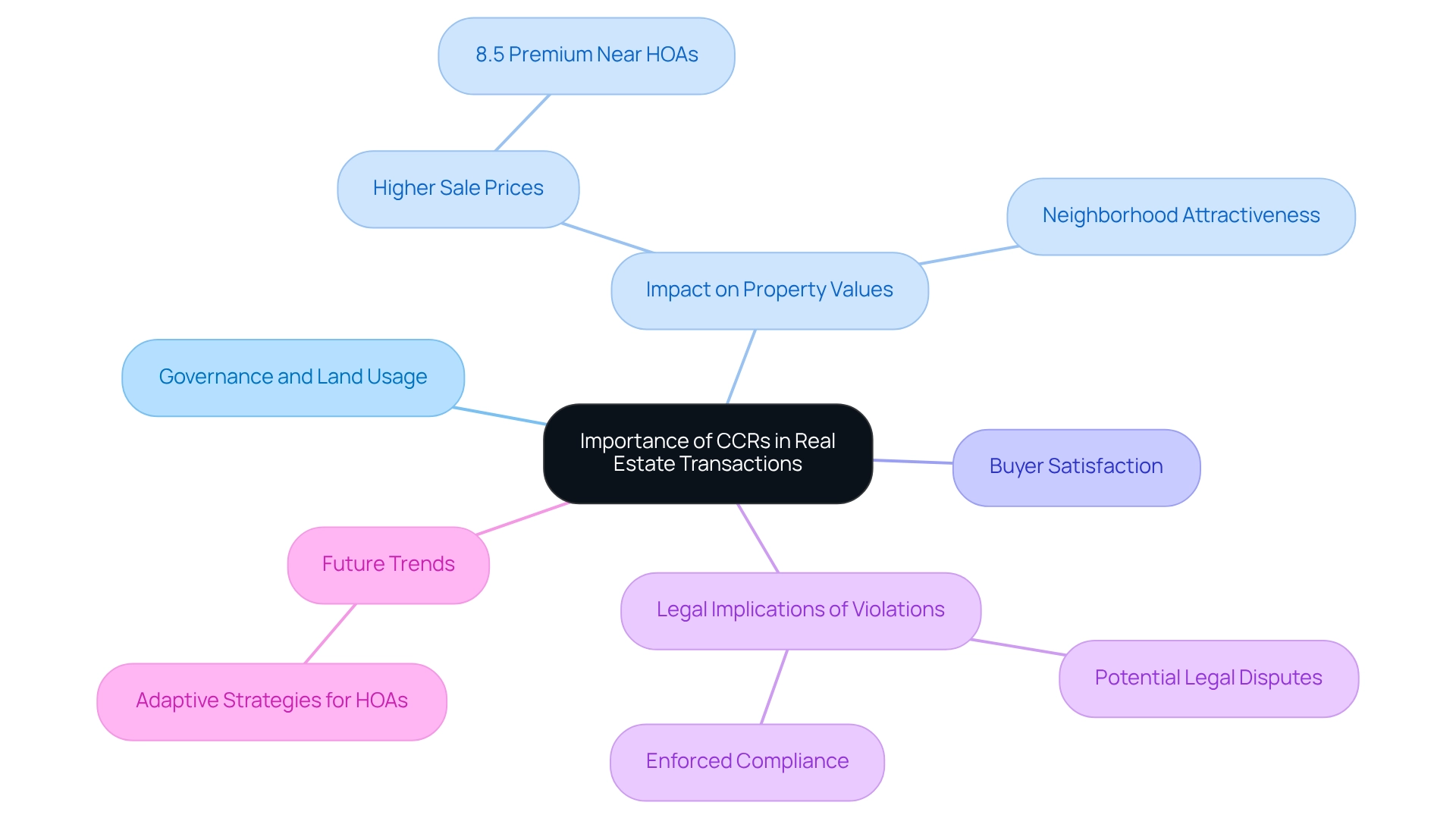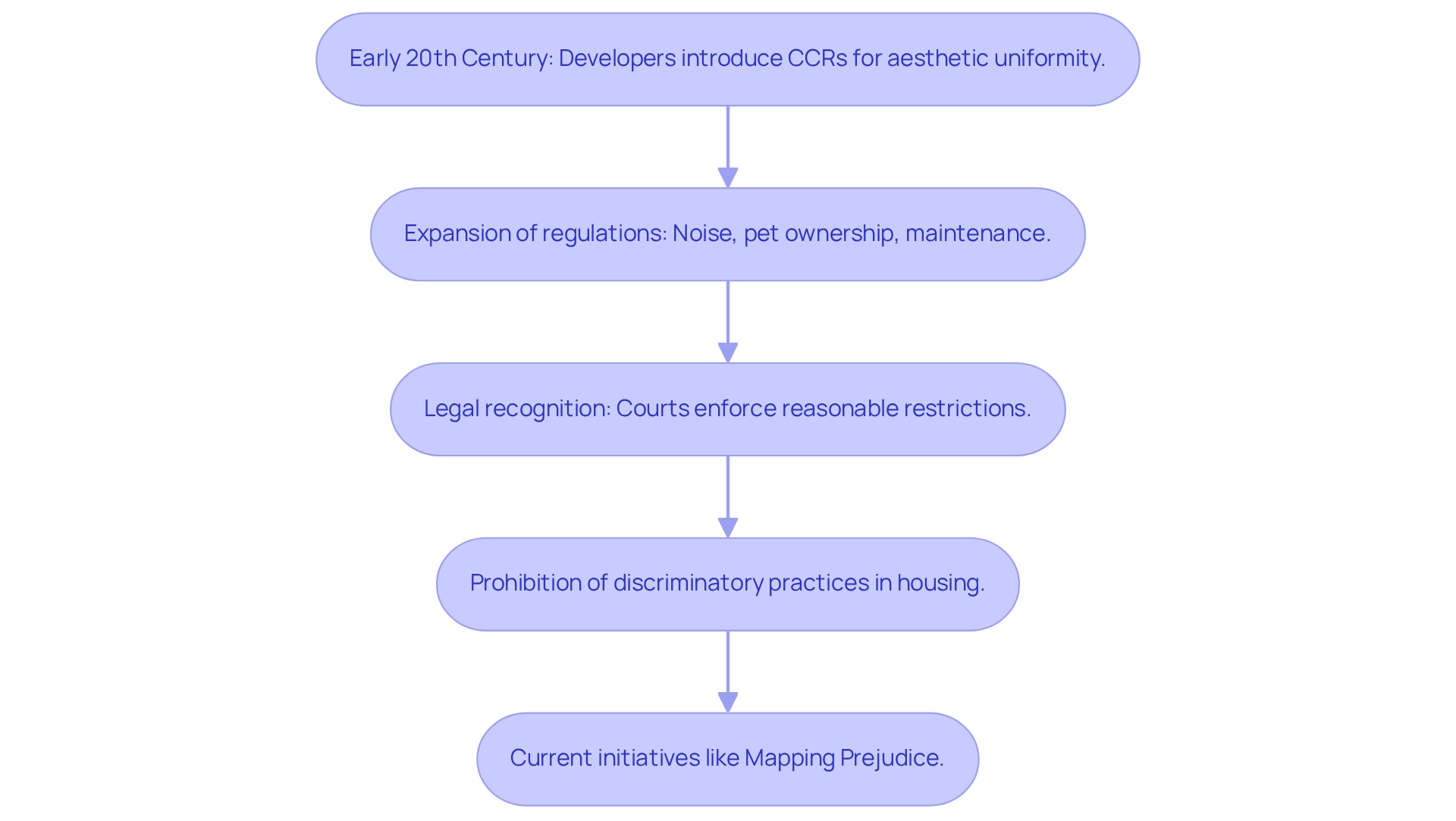Overview
CCRs, or Conditions, Covenants, and Restrictions, serve as legally binding agreements in real estate, dictating how property owners can utilize their land. This framework is designed to maintain property values and enhance neighborhood aesthetics. By enforcing uniform standards among residents, CCRs significantly influence home sale prices and foster community harmony. Their essential role in real estate transactions cannot be overstated, as they not only protect individual investments but also contribute to the overall desirability of neighborhoods.
Introduction
In the realm of real estate, Conditions, Covenants, and Restrictions (CCRs) serve as the backbone of community governance, shaping not only property values but also the very fabric of neighborhood life.
These legally binding agreements dictate how homeowners can utilize their land, encompassing aesthetic choices and maintenance obligations, thereby ensuring a harmonious living environment.
As homeowners associations (HOAs) continue to rise, understanding the intricacies of CCRs becomes essential for both buyers and sellers navigating the complexities of property transactions.
With a rich historical backdrop and evolving regulations, CCRs reflect community standards and carry significant implications for property ownership and neighborhood dynamics.
This exploration delves into the fundamental characteristics, historical context, and practical examples of CCRs, illuminating their vital role in maintaining the integrity and appeal of residential communities.
Define CCRs: Conditions, Covenants, and Restrictions
To grasp the essence of CCRs in real estate, one must recognize that they refer to Conditions, Covenants, and Restrictions—legally binding agreements that dictate how landowners may utilize their property within a designated area or development. These documents delineate the specific dos and don'ts for residents, addressing a range of factors such as property appearance, maintenance obligations, and permissible activities. For example, a CCR might restrict residents from painting their homes in certain colors or mandate that lawns adhere to particular standards.
The primary objective of these regulations is to uphold property values and foster a cohesive neighborhood aesthetic. Notably, a significant proportion of property owners associations (POAs) enforce such restrictions. Reports reveal that:
- 73% of association managers plan to increase assessments in response to rising expenses, underscoring the financial pressures POAs face in maintaining standards.
- Approximately 80% of homeowners associations (HOAs) implement regulations, highlighting their prevalence in residential communities.
In 2021, only 40% of new homes constructed by private homeowners or contractors were situated in HOA-governed areas, showcasing the selective nature of regulation enforcement. The South emerged as the leader in new HOA-controlled homes, with 82% of new single-family residences falling under such governance. This trend underscores the growing presence of covenants in residential neighborhoods, which are crucial for preserving asset values and ensuring neighborhood integrity.
Expert opinions emphasize the importance of covenants in real estate, prompting many industry professionals to explore the question of what CCRs entail, as they acknowledge their role in shaping neighborhood standards and land use. By 2025, understanding CCRs in real estate will remain a vital aspect of community covenants in property transactions, influencing everything from market values to neighborhood aesthetics. According to KRJ Management, in 2021, 2.5 million U.S. property owners were actively engaged as HOA board or committee members, highlighting the substantial public involvement in the enforcement of these regulations.
Contextualize CCRs: Importance in Real Estate Transactions
Covenants, Conditions, and Restrictions (CCRs) in real estate serve as a fundamental framework for governance and land usage, crucial for successful transactions. These regulations are designed to uphold real estate values by ensuring all residents adhere to uniform standards, thereby enhancing the overall appeal of communities. For potential purchasers, understanding what CCRs entail is essential, as these regulations can significantly influence their satisfaction with a home and their capacity for modifications.
Research indicates that homes located in neighborhoods governed by such conditions often command higher sale prices, underscoring their desirability. For instance, a recent study revealed that properties situated within two miles of a homeowners association (HOA) achieve an 8.5% higher sale price compared to those not under HOA governance. This premium underscores the importance of covenants in shaping buyer perceptions and decisions. Additionally, violations of these agreements can lead to serious legal disputes, penalties, or enforced compliance, making it imperative for prospective buyers to thoroughly understand CCRs and scrutinize these documents prior to finalizing a purchase.
As we look to 2025, the financial landscape surrounding HOAs is evolving, prompting boards to adopt flexible strategies for effective regulation management. Thus, understanding CCRs is not only vital for influencing real estate values but also essential for maintaining neighborhood harmony and attractiveness, making them a key consideration in any real estate transaction. Zero Flux, a specialized daily newsletter, highlights these trends and insights, serving as an invaluable resource for real estate professionals navigating the complexities of the market.

Trace the Origins: Historical Development of CCRs
The roots of Conditions, Covenants, and Restrictions (CCRs) can be traced back to the early 20th century, when developers aimed to protect asset values in burgeoning neighborhoods. Initially, these restrictions focused on enforcing uniformity in architectural styles and landscaping, which ensured that neighborhoods maintained a cohesive aesthetic appeal. Over time, the scope of these regulations expanded significantly, incorporating rules on noise, pet ownership, and maintenance of premises—reflecting the evolving needs of communities.
The legal framework governing carbon capture and storage has similarly evolved. Courts have increasingly acknowledged the enforceability of these restrictions, provided they are reasonable and clearly articulated. This evolution is crucial in shaping how collaborative resources function within urban planning, influencing not only property values but also the demographic composition of neighborhoods.
Historically, the execution of collective community rights has had profound implications, particularly regarding discrimination. Federal fair housing regulations now prohibit restrictive covenants from discriminating based on race, color, religion, sex, national origin, familial status, or disability. This addresses the legacy of exclusionary practices that have historically marginalized specific groups. The case study titled 'Legacy of Discrimination in Housing' illustrates the lasting impacts of racial covenants on housing demographics and economic opportunities for disadvantaged groups, emphasizing the necessity for ongoing vigilance in ensuring fair housing opportunities for all. Furthermore, initiatives like the Mapping Prejudice project, as noted by R. Allen, highlight the importance of examining these historical practices to understand their effects on current housing dynamics.
Overall, the historical evolution of community control regulations elucidates what CCRs are in real estate, reflecting a complex interplay between community aesthetics, legal standards, and social equity. This underscores their significance in the real estate landscape. As the newsletter continues to expand, boasting over 30,000 subscribers, understanding what CCRs are in real estate and their development becomes increasingly vital for real estate experts and investors navigating the complexities of the market.

Examine Key Characteristics: Structure and Function of CCRs
Covenants, Conditions, and Restrictions (CCRs) in real estate possess defining characteristics that significantly shape their role. Firstly, these are recorded documents filed with local government offices, ensuring they are publicly accessible. This transparency guarantees that potential purchasers and existing residents are fully informed about what CCRs entail and the regulations governing the area. Secondly, CCRs are enforceable by homeowners' associations (HOAs) or other governing entities, which play a crucial role in upholding neighborhood standards.
Typically, these guidelines encompass specific provisions regarding land use, maintenance, and neighborhood aesthetics. For instance, a CCR may mandate that all homes adhere to a particular landscaping style or prohibit the parking of commercial vehicles in driveways. Understanding CCRs is vital for preserving asset values and fostering a cohesive neighborhood atmosphere. The enforcement of these rules is paramount; breaches can lead to penalties or legal consequences. A notable case study highlights the repercussions of failing to pay HOA fees, which can result in late fees and even foreclosure if ignored. This underscores the importance of understanding CCRs, as HOAs enforce them to protect residents' interests and maintain property values.
Statistics reveal that Florida and California have the highest concentrations of HOAs, while New York frequently experiences some of the highest HOA fees. This geographical variation in CCR enforcement illustrates the diverse regulatory landscape across states. Moreover, local associations contribute significantly to the management of these regulations, offering approximately 97.6 million volunteer hours each year, valued at about $2.908 billion. This level of participation emphasizes the importance of public engagement in upholding community guidelines.
Furthermore, findings from the 2024 Homeowner Satisfaction Survey indicate that 26% of participants rated their overall experience as neutral, reflecting varying perceptions of HOA efficiency in enforcing community guidelines. Overall, the framework and purpose of these entities are essential for ensuring that neighborhoods thrive while safeguarding property values.
Explore Common Examples of CCRs in Real Estate
Common examples of CCRs in real estate encompass regulations governing fencing types, exterior paint colors, and the parking of recreational vehicles. Numerous neighborhoods enforce CCRs, raising the question of what these regulations entail. For instance, many prohibit chain-link fences, favoring wooden or vinyl alternatives to preserve a cohesive neighborhood appearance. Additionally, CCRs often stipulate maintenance responsibilities for common areas, such as parks and swimming pools, ensuring these facilities remain clean and accessible for all residents. This adherence to regulations not only enhances property values but also fosters a sense of pride and unity among residents.
Statistics reveal that compliance with CCR guidelines is essential, as individuals neglecting these rules may face penalties. Homeowners' Association (HOA) fees can be significant and must be paid as long as residents own their property, underscoring the ongoing expenses associated with living in regulated areas. In some cases, property owners confronting CCR violations have sought legal counsel to explore their rights and options, as illustrated in the case study titled 'Navigating CC&R Violations.' This underscores the importance of understanding what CCRs are in real estate and their restrictions. By actively engaging with their HOA, homeowners can address issues and influence decisions that affect their neighborhood, reinforcing the value of regulations in cultivating a well-maintained and visually appealing environment. Furthermore, it is critical for sellers to provide buyers with HOA documents, including CC&Rs, as part of the Colorado real estate contract, ensuring transparency in real estate transactions. Notably, an association cannot prohibit the installation and use of solar energy panels, highlighting the limitations imposed by CCRs on property modifications.
Conclusion
Understanding Conditions, Covenants, and Restrictions (CCRs) is essential for anyone involved in real estate, as these regulations serve as the backbone of community governance. CCRs establish a framework that guides property use, maintenance, and aesthetics, ultimately influencing property values and neighborhood dynamics. Their historical context reveals a long evolution from simple aesthetic controls to more comprehensive regulations that reflect the changing needs and values of communities.
The significance of CCRs in real estate transactions cannot be overstated. They not only help maintain the integrity and appeal of neighborhoods but also protect the financial interests of homeowners. With properties in CCR-governed communities often commanding higher sale prices, understanding these regulations is crucial for prospective buyers. The potential for legal disputes arising from violations further emphasizes the need for thorough examination of CCRs prior to any property transaction.
Moreover, the structure and enforcement of CCRs are vital for fostering community involvement and ensuring compliance. Homeowners associations play a pivotal role in this process, reinforcing community standards and creating a sense of shared responsibility among residents. As the landscape of real estate continues to evolve, so too does the importance of CCRs in shaping residential communities.
In summary, CCRs are fundamental to the governance of residential neighborhoods, influencing everything from property values to community aesthetics. Both buyers and sellers must navigate these regulations with care, ensuring they understand their implications for property ownership and neighborhood life. Embracing the role of CCRs can lead to more harmonious living environments and protect the investments made in homes.




